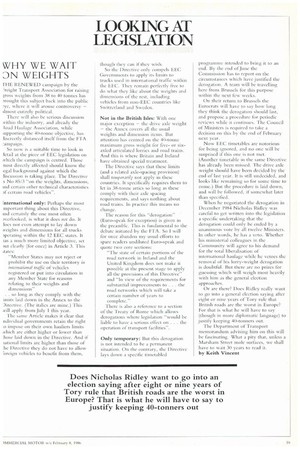WHY WE WAIT 'DIN WEIGHTS
Page 59

If you've noticed an error in this article please click here to report it so we can fix it.
[HE RENEWED campaign by the P'reight Transport Association for raising 4ross weights from 38 to 40 tonnes has 3rought this subject hack into the public rye, where it will arouse controversy — limos( entirely political.
There will also be serious discussion xithin the industry, and already the load Haulage Association, while ;upporting the 40-tonne objective, has iiscreetly distanced itself from the FTA :ampaign.
So now is a suitable time to look in letail at the piece or EEC legislation on mhich the campaign is centred. Those nost directly affected should know the egal background against which the liscussion is taking place. The Directive s No 85/3 ''on the weights, dimensions, ind certain other technical characteristics of certain road vehicles'.
International only: Perhaps the most mportant thing about this Directive, aid certainly the one most often overlooked, is what it does not do. It ioes not even attempt to lay down 'eights and dimensions for all trucks operating within the 12 EEC states. It as a much more limited objective, set out clearly (for once) in Article 3. This ;taws: 'Member States may not reject or prohibit the use on their territory in international traffic of vehicles registered or put into circulation in any Member State for reasons relating to their weights and dimensions'.
. . so long as they comply with the Units laid down in the Annex to the Directive. (The italics are mine.) This Nill apply from July 1 this year.
The same Article makes it clear that ndividual governments retain the right :o impose on their own hauliers limits Arhich are either higher or lower than :hose laid down in the Directive. And if lational limits arc higher than those of :he Directive they do not have to allow 'oreign vehicles to benefit from them, though they can if they wish.
So the Directive only compels EEC Governments to apply its limits to trucks used in international traffic within the EEC. They remain perfectly free to do what they like about the weights and dimensions of the rest, including vehicles from non-EEC countries like Switzerland and Sweden.
Not in the British Isles: With one major exception — the drive axle weight — the Annex covers all the usual weights and dimension items. But attention has centred on the 40-tonne maximum gross weight for fiveor sixaxled articulated lorries and road trains. And this is where Britain and Ireland have obtained special treatmem.
The Directive says that these limits (and a related axle-spacing provision) shall temporarily not apply in these countries. It specifically requires them to let in 38-tonne artics so long as these comply with their axle spacing requirements, and says nothing about road trains. In practice dims means no change.
The reason for this "derogation' (Euro-speak for exception) is given in the preamble. This is fundamental to the debate initiated by the ETA. So 1 will for once abandon my usual efforts to spare readers undiluted Euro-speak and quote two core sections: "The state of certain portions of the road network in Ireland and the United Kingdom does not make it possible at the present stage to apply all the provisions of this Directive" and "In view of the requirements for substantial improvements to . . . the road networks which will take a certain number of years to complete."
There is also a reference to a section of the Treaty of Rome which allows derogations where legislation "would be liable to have a serious effect on . . . the operation of transport facilities-.
Only temporary: But this derogation is not intended to he a permanent situation. On the contrary, the Directive lays down a specific timetabled
programme intended to bring it to an end. By the end ()finite the
Commission has to report on the circumstances which have justified the derogation. A team will be travelling here from Brussels for this purpose within the next few weeks.
On their return to Brussels the Eurocrats will have to say how long they think the derogation should last, and propose a procedure for periodic reviews while it continues. The Council of Ministers is required to take a decision on this by the end of February next year.
Now EEC timetables are notorious for being ignored, and no one will be surprised if this one is not met.
(Another timetable in the same Directive has already been missed. The drive axle weight .should have been decided by the end of last year. It is still undecided, and looks like remaining so for some time to conic.) But the procedure is laid down, and will be followed, if somewhat later than specified.
When he negotiated the derogation in December 1984 Nicholas Ridley was careful to get written into the legislation a specific undertaking that the derogation could only be ended by a unanimous vote by all twelve Ministers. In other words, he has a veto. Whether his ministerial colleagues in the Community will agree to his demand for the total liberalisation of international haulage while he vetoes the removal of his lorry-weight derogation is doubtful. But there are no prizes for guessing which will weigh most heavily with him as the general election approaches.
Or are there? Does Ridley really want to go into a general election saying after eight OT nine years of Tory rule that British roads are the worst in Europe? For that is what he will have to say (though in more diplomatic language) to justify keeping 40-tonners out.
The Department of Transport memorandum advising him on this will he fascinating. What a pity that, unless a Marsham Street mole surfaces, we shall have to wait 30 years to read it.
by Keith Vincent




























































